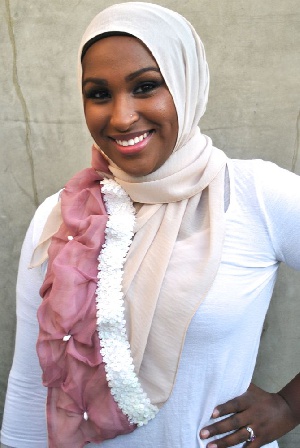Three rules for women dress code in Islam
Hijab is a symbol of chastity and a sign of dignity and piety. The kind of hijab that women wear on the World Hijab Day celebrated on 1 February every year often makes a mockery of this divinely-ordained obligation, and does more harm than good. That is because with regard to hijab as prescribed in Islam, there are conditions and criteria which, if they are met, then it is the correct Islamic hijab that Allah has enjoined upon women.
But if these conditions are not met – in full or in part – then this cannot be called correct Islamic hijab.
2.1 FIRST RULE: THE BEST GARMENT [Holy Quran 7:26] "O children of Adam, we have provided you with garments to cover your bodies, as well as for luxury. But the best garment is the garment of righteousness. These are some of God's signs, that they may take heed." This is a BASIC rule of DRESS CODE in the Quran.
2.2 SECOND RULE: COVER YOUR BOSOMS The second rule can be found in Holy Quran Chapter 24:31. Here God orders the women to cover their bosoms whenever they dress up. But before quoting Holy Quran Chapter 24:31 let us review some crucial words that are always mentioned with this topic, namely "Hijab" and "Khimar”
THE WORD "HIJAB" in the QURAN: "Hijab" is the term used by many Muslims women to describe their head cover that may or may not include covering their face except their eyes, and sometimes covering also one eye.
The Arabic word "Hijab" can be translated into veil or yashmak. Other meanings for the word "Hijab" include, screen, cover(ing), mantle, curtain, drapes, partition, division, and divider. Can we find the word "Hijab" in the Quran?? The word "Hijab" appeared in the Quran 7 times, five of them as "Hijab" and two times as "Hijaban," these are Holy Quran Chapter 7:46, Holy Quran Chapter 33:53, Holy Quran Chapter 38:32, Holy Quran Chapter 41:5, Holy Quran Chapter 42:51, Holy Quran Chapter 17:45 & Holy Quran Chapter 19:17.
2.3 THIRD RULE: LENGTHEN YOUR GARMENTS The first regulation of DRESS CODE for Muslim women is in Holy Quran Chapter 7:26, the second is in Holy Quran Chapter 24:31 and the third is in Holy Quran Chapter 33:59 [Holy Quran 33:59] O prophet, tell your wives, your daughters, and the wives of the believers that they shall LENGTHEN their garments.
Thus, they will be recognized and avoid being insulted. God is Forgiver, Most Merciful. In Holy Quran Chapter 33:59, God sets the other regulation for the dress code for the Muslim women during the prophet's life.
It is clear from the above verses that the DRESS CODE for the Muslim women (Submitters) according to the Quran is righteousness and modesty. God knows that this modesty will be understood differently in different communities and that is why He left it open to us to decide for ourselves. Decide, after righteousness what is modesty.
Modesty for a woman who lives in New York may not be accepted by a woman who lives in Cairo Egypt or Lagos. Modesty of a woman who lives in Cairo, Egypt, Lagos may not be accepted by a woman who lives in Saudi Arabia.
3.0 MEN’S DRESS CODE We discuss summary of dress code for men as follows: - 1. The basic principle concerning everything that is worn is that it is halaal and permissible, except for that concerning which there is a text to state that it is haraam, such as silk for males, because the Prophet (peace and blessings of Allaah be upon him) said: “These two [gold and silk] are forbidden for the males of my ummah and permissible for the females.
” Narrated by Ibn Maajah, 3640; classed as saheeh by al-Albaani in Saheeh ibn Maajah. Similarly, it is not permissible to wear the skin of a dead animal (one that has died of natural causes) unless it has been tanned. With regard to wearing clothes made of wool, goat hair and camel hair, these are pure and permissible. For more information on the use of the skin of dead animals after tanning.
2. It is not permissible to wear thin or see-through clothing that does not conceal the ‘awrah.
3. It is haraam to imitate the mushrikeen and kuffaar in their manner of dress, so it is not permissible to wear clothing that is unique to the kuffaar. It was narrated that ‘Abd-Allaah ibn ‘Amr ibn al-‘Aas said: The Messenger of Allaah (peace and blessings of Allaah be upon him) saw ‘Ali wearing two garments dyed with safflower and said: “These are garments of the kuffaar; do not wear them.”Narrated by Muslim, 2077.
4. It is haraam for women to imitate men and men to imitate women in the way they dress, because the Prophet (peace and blessings of Allaah be upon him) cursed the men who imitate women and the women who imitate men.” Narrated by al-Bukhaari, 5546.
5. It is Sunnah for a Muslim to start with the right when dressing, and to say, Bismillaah (In the name of Allaah), and to start with the left when taking clothes off. It was narrated that Abu Hurayrah said: The Messenger of Allaah (peace and blessings of Allaah be upon him) said: “When you get dressed and when you do wudoo’, start on the right.” Narrated by Abu Dawood, 4141; classed as saheeh by al-Albaani in Saheeh al-Jaami’, 787.
6. It is Sunnah for the one who is putting on a new garment to thank Allaah and make du’aa’. It was narrated that Abu Sa’eed said: When the Messenger of Allaah (peace and blessings of Allaah be upon him) put on a new garment, he would call it by its name, whether it was a turban, a shirt or a cloak, then he would say:
“Allaahumma laka al-hamd anta kasawtanihi as’aluka khayrahu wa khayri ma suni’a lah wa a’oodhu bika min sharrihi wa sharri ma suni’a lah (O Allaah, to You be all praise. You have clothed me with it. I ask You for the good of it and the good for which it was made, and I seek refuge with You from the evil of it and the evil for which it was made).”Narrated by al-Tirmidhi, 1767; Abu Dawood, 4020; classed as saheeh by al-Albaani in Saheeh al-Jaami’, 4664.
7. It is Sunnah to pay attention to keeping one's clothes clean, without feeling arrogant or exaggerating about that. It was narrated from ‘Abd-Allaah ibn Mas’ood that the Prophet (peace and blessings of Allaah be upon him) said: “No one will enter Paradise in whose heart is a mustard-seed of arrogance.” A man said: “What if a man likes his clothes to look nice and his shoes to look nice?” He said: “Allaah is Beautiful and loves beauty; arrogance means rejecting the truth and looking down on people. “Narrated by Muslim, 91.
8. It is mustahabb to wear white clothes It was narrated that Ibn ‘Abbaas said: The Messenger of Allaah (peace and blessings of Allaah be upon him) said: “Wear white clothes, for they are the best of your clothes, and shroud your dead in them.” Narrated by al-Tirmidhi, 994, hasan saheeh. This is what the scholars regarded as mustahabb. Also narrated by Abu Dawood, 4061; Ibn Maajah, 1472.
9. It is haraam for the Muslim man to let any garment he wears hang down beneath his ankles (an action known as isbaal); the limit for any garment is the ankles.
It was narrated from Abu Hurayrah (may Allaah be pleased with him) that the Prophet (peace and blessings of Allaah be upon him) said; “Whatever of the lower garment is beneath the ankles is in the Fire.”Narrated by al-Bukhaari, 5450.
It was narrated from Abu Dharr that the Prophet (peace and blessings of Allaah be upon him) said: “There are three to whom Allaah will not speak on the Day of Resurrection and will not look at them or praise them, and theirs will be a painful torment.”
The Messenger of Allaah (peace and blessings of Allaah be upon him) repeated it three times. Abu Dharr said: “May they be doomed and lost; who are 4 they, O Messenger of Allaah?” He said: “The one who lets his garment hang beneath his ankles, the one who reminds others of favours he has done, and the one who sells his product by means of false oaths.” Narrated by Muslim, 106.
10. It is haraam to wear garments of fame and vanity, which means a garment that stands out from others so that people will look at the wearer and he will become known for it.
It was narrated that Ibn ‘Umar said: The Prophet (peace and blessings of Allaah be upon him) said: “Whoever wears a garment of fame and vanity, Allaah will dress him in a garment like it on the Day of Resurrection.”
According to another version, “…then set it ablaze.” And according to a third version, “will dress him in a garment of humiliation.” Narrated by Abu Dawood, 4029; Ibn Maajah, 3606 and 3607; classed as hasan by Shaykh al-Albaani in Saheeh al-Targheeb, 2089
Opinions of Thursday, 3 August 2017
Columnist: Alhaji Alhasan Abdulai
Men and women’s dress code in Islam and the world (2)
Entertainment














